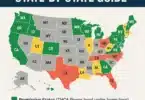As Canadian’s wrap-up warm for winter they’ll be sharing one thing in common with their newest domestic industry – a hope the icy chill will be over soon.
With average Canadian cannabis company share prices down by over 50%, this year, analysts are contemplating a significant sector shake-down. And, this month’s results from Canada’s Licensed Producers, have once more underwhelmed – with under-fire executives highlighting a string of on-going issues.
Somewhere, or another, stressed company bosses will have flagged-up at least one of the following;
- A shortage of stores
- Restrictive rules on brand development
- Falling prices
- Rising stock levels
- Sluggish – and sometimes negative – revenue growth
- An inability to make profit
- A lack of fresh capital
- Little appetite for deals
- Cultivation cut backs
- Leading to job cuts
It’s a fairly lengthy gripe – or even, charge – sheet but in the face of all of this maudlin sentiment some analysts predict brighter times ahead. As they see it; once this icy blast lifts, and the White Witch’s bitter grip thaws, the industry will welcome a fresh and bountiful cannabis spring.
Just 8 Firms Left
Analysts at Mackie Research pulled no punches when summarising the recent round of pitiful results from the Canadian sector, reports Bloomberg. Calling their cumulative performances as ‘disastrous’ they speculated on which companies will still be standing in a year’s time.
They estimated that 21 out of 50 publicly-traded cannabis companies analysed have less than six months of cash left to burn. Other analysts say they expect 30 to 40 per cent of cannabis companies will ‘soon become distressed, go bankrupt or be acquired by another company’.
And, a third, reckons that within five years there will be just eight main Canadian cannabis companies standing.
Poster Child
The world’s largest cannabis company Canopy Growth does not suffer from a lack of capital following its U.S$ 4 billion investment from Constellation Brands. However, in many other areas it is a poster child for the sector’s woes.
Its second-quarter loss hit $374.6 million with net revenues of $76.6 million down from $90.5 million in the prior quarter. Whilst it sold a record amount of cannabis the country’s over-supply crushed prices and margins
“It’s fair to say it’s been a challenging couple of quarters in the cannabis sector,” said CEO Mark Zekulin. “The market opportunity [in Canada] is not living to expectations.”
Also suffering is second largest company Aurora Cannabis which reported quarterly net revenue of $75.2 million well below the average analyst estimate of $90.6 million. Its sales into the Canadian recreational market tumbled 33% to $30 million, and it recorded a loss of $39.7 million.
In an effort to cut costs it said it was ceasing construction at an $80 million facility in Denmark.
Not Enough Pot Shops
Mr Zekulin highlights the lack of domestic retailers, especially in the most populous sate of Ontario; it has a population of around 15 million but only 20 stores – one for every 600,000 people. He said “There are not enough stores, there is enough supply and the inability to get more stores rolled out is dramatically hurting the sector.”
Health Canada’s figures for August show stocks of dried cannabis have nearly tripled to 328,000 kilograms this year, with a total inventory almost 30 times sales, reports the Financial Post website. The share price crash has also seen the once-bountiful capital markets dry up, with some companies now having to offload real estate assets raise cash.
Innovative Industrial Properties, the largest cannabis-focused real estate investment trust, completed U.S. $375.6 million worth of deals in 2019, saying its deal ‘pipeline has never been more vigorous’ reports BNN Bloomberg.
The industry crisis has seen the Cannabis Council of Canada write to Prime Minister Justin Trudeau for help addressing some of the industry’s most pressing challenges. These include cracking down on the black market which still accounts for over 50% of sales.
Budget Range
Some firms like Hexo, have responded by launching budget price products. Its ‘Original Stash’ line retails at around $3.40 per gram – about half the average Canadian selling price.
The strict rules on packaging are also preventing the development of popular brands which can help generate interest and activity in the retail sector. Then there are compliance issues at companies such as, the inaptly named, CannTrust over unlicensed growing rooms, which has led to job losses, which now common across the sector.
In the light of all the issues short sellers – those betting share prices will fall further – are taking positions on Canadian cannabis stocks. MKM analyst Bill Kirk said: “Rather than be wildly profitable in two years, we expect the Canadian LPs to be roughly break-even.”
Nevertheless, despite of the doom and gloom, the long-term sentiment of many market-watchers is upbeat. One of the first to call the end to the sell-off was Cantor Fitzgerald, it says the positives will outweigh the negatives in 2020. “Valuations are at two-year lows, and we deem them attractive based on the long-term opportunity,” says its analyst Pablo Zuanic.
More store openings are expected, with Canopy projecting an average of 40 new stores opening in Ontario each month beginning in January, reports Motley Fool. And, the January launch of Cannabis 2.0; the new market for products such as edibles, gummies and other diversified retail lines will be a boost to sales.
Annual Revenues To Double
New Frontier Data estimates that 1.5 million adults consumed legal cannabis in the first year of legalisation, with that total expected to reach 7.3 million by 2024, with annual revenues more than doubling to C$5.8 billion in that time.
This diversification into new products is matched by concerted efforts at geographical diversification. Many leading Canadian cannabis companies have expanded into Europe; a market which is expected to surpass North America’s in size, and many are also investing in the U.S. CBD market which is experiencing a massive boom.
As Matt Benjamin from the InvestmentU website points out cannabis is still a ‘nascent industry with a bunch of problems yet to solve’. He says the institutional investors will eventually arrive and says there is ‘little doubt the cannabis industry will continue to grow’.
While the sector may be in a for ‘long-hard winter’ there is hope – and even an expectation – that this icy blast will eventually thaw and spring will return to Narnia. But, by then Canada’s cannabis landscape may look markedly different than the one that exists today.
For more stories like this one, subscribe to the CBD Business Weekly Newsletter.







